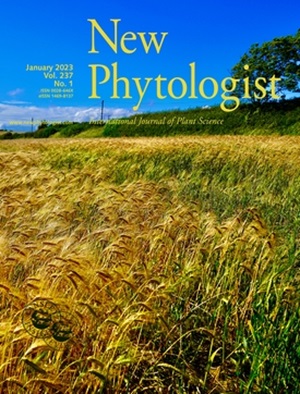Increased chloroplast occupancy in bundle sheath cells of rice hap3H mutants revealed by Chloro-Count: a new deep learning–based tool
IF 8.3
1区 生物学
Q1 PLANT SCIENCES
引用次数: 0
Abstract
- There is an increasing demand to boost photosynthesis in rice to increase yield potential. Chloroplasts are the site of photosynthesis, and increasing their number and size is a potential route to elevate photosynthetic activity. Notably, bundle sheath cells do not make a significant contribution to overall carbon fixation in rice, and thus, various attempts are being made to increase chloroplast content specifically in this cell type.
- In this study, we developed and applied a deep learning tool, Chloro-Count, and used it to quantify chloroplast dimensions in bundle sheath cells of OsHAP3H gain- and loss-of-function mutants in rice.
- Loss of OsHAP3H increased chloroplast occupancy in bundle sheath cells by 50%. When grown in the field, mutants exhibited increased numbers of tillers and panicles. The implementation of Chloro-Count enabled precise quantification of chloroplasts in loss- and gain-of-function OsHAP3H mutants and facilitated a comparison between 2D and 3D quantification methods.
- Collectively, our observations revealed that a mechanism operates in bundle sheath cells to restrict chloroplast occupancy as cell dimensions increase. That mechanism is unperturbed in Oshap3H mutants but loss of OsHAP3H function leads to an increase in chloroplast numbers. The use of Chloro-Count also revealed that 2D quantification is compromised by the positioning of chloroplasts within the cell.
基于深度学习的新工具Chloro-Count揭示了水稻hap3H突变体束鞘细胞叶绿体占用率的增加
人们越来越需要促进水稻的光合作用,以提高产量潜力。叶绿体是光合作用的场所,增加叶绿体的数量和大小是提高光合作用活性的潜在途径。值得注意的是,束鞘细胞对水稻的整体碳固定没有显著贡献,因此,人们正在尝试增加这种细胞类型的叶绿体含量。在这项研究中,我们开发并应用了一个深度学习工具,Chloro-Count,并使用它来量化水稻OsHAP3H增益和丧失功能突变体束鞘细胞的叶绿体尺寸。OsHAP3H缺失使束鞘细胞叶绿体占用率增加50%。当在田间生长时,突变体表现出分蘖和穗数增加。利用Chloro-Count技术,可以对丧失和获得功能的OsHAP3H突变体中的叶绿体进行精确定量,并便于对2D和3D定量方法进行比较。总的来说,我们的观察揭示了一种机制在束鞘细胞中起作用,随着细胞尺寸的增加,限制叶绿体的占用。这种机制在Oshap3H突变体中不受干扰,但Oshap3H功能的丧失会导致叶绿体数量的增加。氯计数的使用也揭示了二维定量受到叶绿体在细胞内定位的损害。
本文章由计算机程序翻译,如有差异,请以英文原文为准。
求助全文
约1分钟内获得全文
求助全文
来源期刊

New Phytologist
生物-植物科学
自引率
5.30%
发文量
728
期刊介绍:
New Phytologist is an international electronic journal published 24 times a year. It is owned by the New Phytologist Foundation, a non-profit-making charitable organization dedicated to promoting plant science. The journal publishes excellent, novel, rigorous, and timely research and scholarship in plant science and its applications. The articles cover topics in five sections: Physiology & Development, Environment, Interaction, Evolution, and Transformative Plant Biotechnology. These sections encompass intracellular processes, global environmental change, and encourage cross-disciplinary approaches. The journal recognizes the use of techniques from molecular and cell biology, functional genomics, modeling, and system-based approaches in plant science. Abstracting and Indexing Information for New Phytologist includes Academic Search, AgBiotech News & Information, Agroforestry Abstracts, Biochemistry & Biophysics Citation Index, Botanical Pesticides, CAB Abstracts®, Environment Index, Global Health, and Plant Breeding Abstracts, and others.
 求助内容:
求助内容: 应助结果提醒方式:
应助结果提醒方式:


